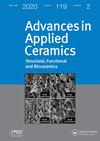热防护用硅酸铝纤维- siboc复合泡沫的制备
IF 1.6
4区 材料科学
Q3 MATERIALS SCIENCE, CERAMICS
引用次数: 0
摘要
在本研究中,通过一种简单、经济、易于扩展的方法实现了硅酸铝纤维嵌入SiBOC基复合泡沫材料。使用聚乙烯醇作为粘合剂,将硅酸铝羊毛转化为可压缩的预成型料。预成型体用甲基乙烯基硼硅氧烷(MVBS)浸渍,然后在惰性气氛中1400℃热处理。MVBS浓度在29 ~ 54 wt.%范围内变化,复合泡沫的密度、抗压强度和导热系数分别在0.71 ~ 0.46 g/cc、0.79 ~ 0.39 MPa和0.21 ~ 0.13 Wm−1K−1范围内调节。虽然观察到铝硅酸盐纤维的掺入降低了复合泡沫的导热系数,但它对其抗压强度没有贡献。将泡沫暴露在1300°C的空气中90分钟不会改变其密度,但由于改善了纤维基质的附着力和裂纹的圆润,其抗压强度提高了46%。本文章由计算机程序翻译,如有差异,请以英文原文为准。
Preparation of aluminosilicate fiber-SiBOC composite foams for thermal protection applications
ABSTRACT In this study, aluminosilicate fiber-embedded SiBOC matrix composite foams are realised by a simple, cost-effective and easily scalable method. Aluminosilicate wool is transformed into a compressible preform using polyvinyl alcohol as a binder. The preforms are impregnated with methylvinylborosiloxane (MVBS), followed by heat treatment at 1400°C in an inert atmosphere. The composite foam’s density, compressive strength and thermal conductivity are modulated in the ranges 0.71–0.46 g/cc, 0.79–0.39 MPa and 0.21–0.13 Wm−1K−1, respectively, by varying MVBS concentration from 29 to 54 wt.%. While the incorporation of aluminosilicate fibers was observed to lower the thermal conductivity of the composite foams, it did not contribute to their compressive strength. Exposure of the foams to air at 1300°C for 90 min didn’t change their density, while it increased the compressive strength by up to 46% due to improved fiber-matrix adhesion and rounding of cracks.
求助全文
通过发布文献求助,成功后即可免费获取论文全文。
去求助
来源期刊

Advances in Applied Ceramics
工程技术-材料科学:硅酸盐
CiteScore
4.40
自引率
4.50%
发文量
17
审稿时长
5.2 months
期刊介绍:
Advances in Applied Ceramics: Structural, Functional and Bioceramics provides international coverage of high-quality research on functional ceramics, engineering ceramics and bioceramics.
 求助内容:
求助内容: 应助结果提醒方式:
应助结果提醒方式:


